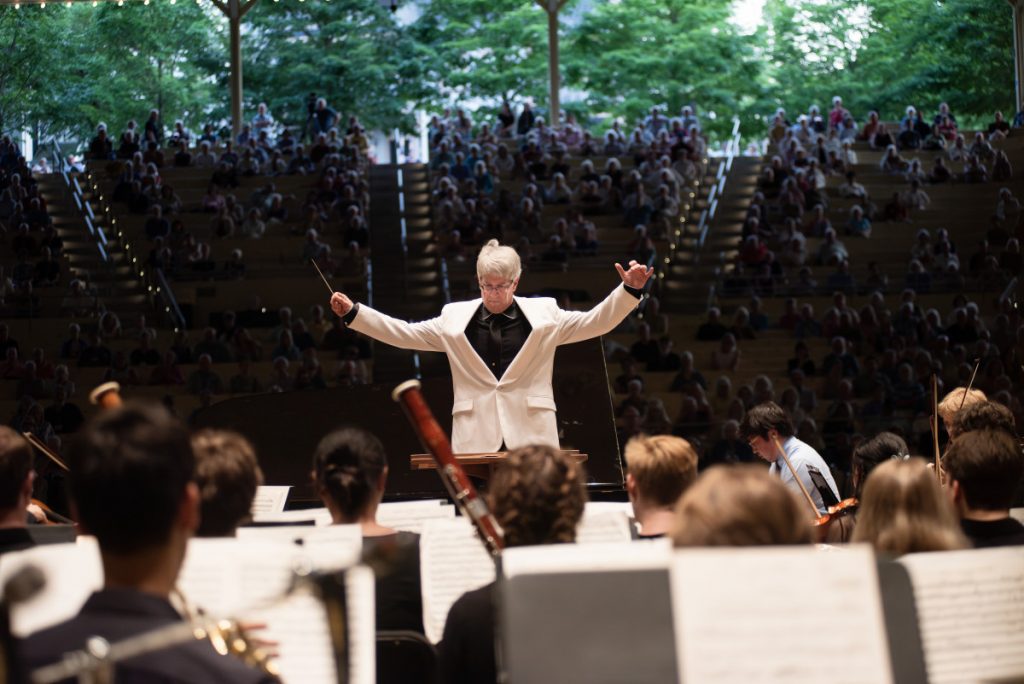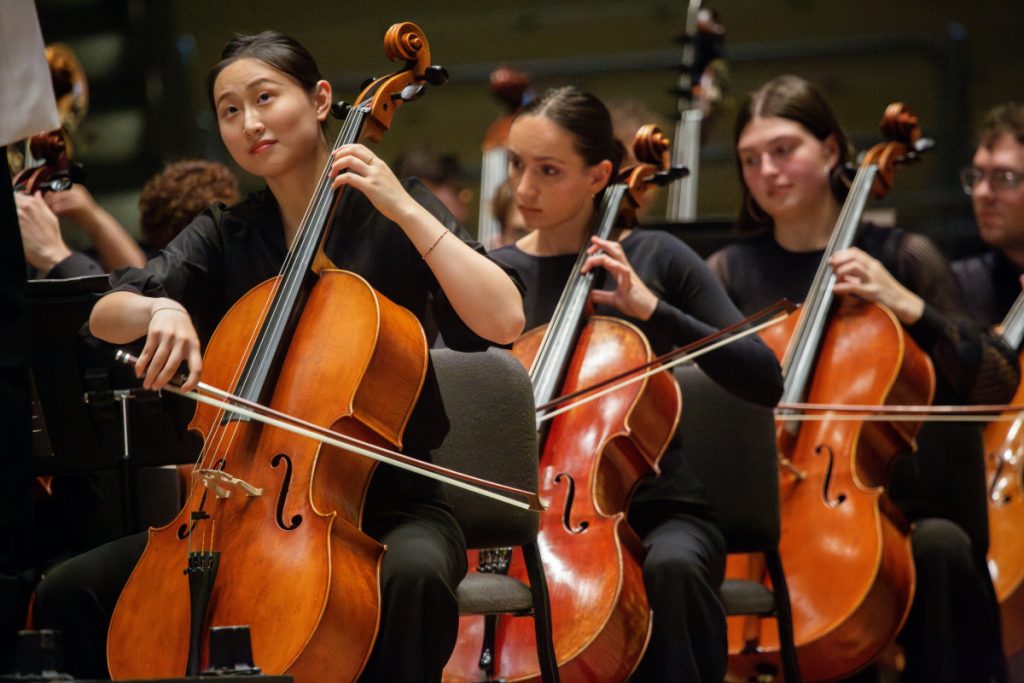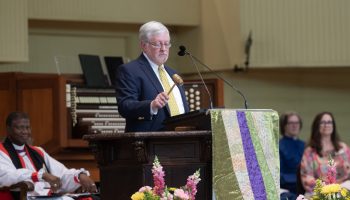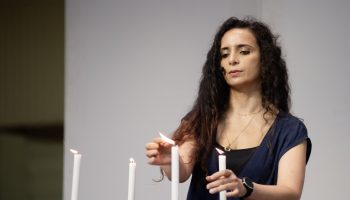

Gabriel Weber
Staff Writer
As the summer progresses, the Music School Festival Orchestra students’ growth is palpable, said School of Music Artistic Director Timothy Muffitt, and tonight, the audience is lucky enough to bear witness to the culmination of the musicians’ effort.
“We grow together as a musical unit here, and this orchestra just plays so beautifully — every minute of working with them has been a joy,” Muffitt said. “I will miss them a lot. None of us, including the students, could sustain this level of intensity indefinitely — it is a great seven weeks.”
At 8:15 p.m. tonight in the Amphitheater, Muffitt leads the MSFO in its final performance of the season. The musicians will be playing Michael Torke’s “Javelin,” Pyotr Tchaikovsky’s “Francesca da Rimini” and Béla Bartók’s “Concerto for Orchestra.”
Muffitt prioritizes student experience when curating the season, choosing Bartók and Tchaikovsky so students get to play pieces that are a part of the standard repertoire; he also considers David Effron Conducting Fellow Hannah Schendel’s experience in giving her a substantial work to lead.
She will be maestro for the symphonic poem “Francesca da Rimini,” a tale of doomed love, based on historical events. Francesca is betrothed to a man named Giovanni; however, upon meeting Giovanni’s younger brother Paolo, the two fall in love. When Giovanni discovers the affair, he murders them both. In Dante Alighieri’s Inferno, Dante finds the lovers entwined in the second circle of hell.
“It tells a story, so it’s very visually descriptive,” Schendel said. “It’s fun, especially the studying process, to imagine the tone qualities and the plot that’s happening, then finally bring it to life.”
Since it is a somewhat longer piece at 25 minutes, one of the challenges is having a zoomed-out view of the work while also juggling the specificity of each moment. Trumpet player Kirk Morrison must focus on these precise moments, as the brass are crucial for building the turbulent atmosphere.
“The brass comes in at very dramatic moments. There’s a lot of great brass moments, but also, there’s a lot of incredible woodwind moments to listen to,” Morrison said. “That’s one of my favorite parts of playing in the orchestra — listening to my colleagues because I can take away my own musical ideas just by their artistry. That’s why I really enjoy that work.”
Oboist Kearsen Erwin, a second-year MSFO student, said Tchaikovsky’s language is quite universal. Still, this composition is unique in that Inferno inspired the narrative.
“Part of the challenge here is shifting character so quickly, being able to sit in this anger and these brooding bubbles of hell, then being able to put that away and come to a beautiful love scene that becomes unfolded in the clarinet and eventually moves through the rest of the wind section,” Erwin said. “It’s just such dynamic music; it’s always changing.”
A stark contrast to the fiery tragedy of “Francesca da Rimini,” Torke’s “Javelin” was commissioned for the Olympics and serves as an engaging concert opening, Muffitt said. He loves to do work by living composers, finding “Javelin” to be incredibly uplifting and a beautiful way to open their final program.
“Audiences love (‘Javelin’) immediately from the very first moment,” Muffitt said. “It’s just very appealing music.”
As the pieces have to be performance-ready in the six rehearsals they have, musicians must come to practice having already solved the biggest technical problems of the piece, while fitting in the nuances of their own playing into the bigger collaboration of the orchestra.
“This is lots of bright colors, lots of fast moving notes and lots of, lots of inertia that gets created through this piece. It’s very exciting to play — that being said, there are about a million notes that we have to play, and they don’t lie particularly well on the instrument,” Erwin said. “So learning that piece and performing it at a high caliber is a challenge in and of itself.”
“Concerto for Orchestra” begins with a stern first movement, according to Bartók, and closes out with a life-asserting finale. It is a top-five favorite piece for Morrison — in part because it is one of the most prominently featured trumpet pieces the students have.
“It’s very exciting to finally play this work because I’ve been working on the excerpts from this piece for a very long time. When you get to play something that you’ve worked on, not in context with the rest of the orchestra, that’s just really exciting,” Morrison said. “That’s another reason why I’ve loved Chautauqua — I’ve gotten to put all the hard work I’ve done on these small selections into a larger scale.”
Erwin is also most excited for this piece, as it is an essential staple in the orchestral repertoire. Additionally, Bartók was heavily influenced by Hungarian folk music: he recorded thousands of different folk melodies for inspiration, which created rhythmic complexity through irregular meters.
“It is the piece that showcases literally every member of the orchestra, so it shows you how an orchestra is — who they are and how they make decisions together,” Erwin said. “Bartók was obsessed with detail, so there’s many instructions on the page you have to follow, and beyond that, you have to take all those details and just sing it through as if you were a folk singer out in the country of Hungary. I think that’s one of the bigger challenges — trying to marry those precise details and unevenness with the natural.”
Having been pushed into youth sports programs, Erwin found a reprieve in band, as he didn’t have a competitive bone in his body. He remembers waiting in line for the oboe and percussion tryouts, as they were in the same room. While all the other students were waiting for percussion, Erwin was the sole hopeful oboist.
Playing the oboe, he found, had a unique feeling. He had a great time, but continued on with tryouts.
“I hiked to the next room, which is a clarinet room,” Erwin said. “Well, then we do the clarinet thing, and then (my teacher was) like, ‘I think you’d be a really good clarinet player, but I think you’d be a great oboist.’ ”
Morrison started playing trumpet in fifth grade when he found one in his attic and brought it to school the next day.
“The reason I kept coming back was because it was something that naturally worked really well for me, and I just enjoyed playing it,” Morrison said. “I really enjoyed collaborating with other people and creating something that was bigger than what I could do myself.”
This is Morrison’s first year with the MSFO; one of the main things he has appreciated is that there is time outside of rehearsal to connect with his peers and grow long-lasting relationships. Attachments with other musicians, the audience and the community is an integral part of music-making.
“My first summer here, it was a real culture shock into how intense a program can really be,” Erwin said. “This year, it was more of a coming home; Chautauqua makes you feel at home for some reason. The community around here is just so vibrant and always in search of something more.”
There are 83 artists in the MSFO who play music together, go hiking together and eat meals together. The building of these relationships truly shows up in the way the music sounds.
“One of the miracles of the symphony orchestra is how much happens at such a high level of nuance and a high level of complexity, without even saying a word. That is the result of this incredible bond that every musician in that orchestra has with every other musician,” Muffitt said. “There’s so much that happens at the intuitive level; that’s where this growth comes into play and where that bond between every individual in the orchestra just gets stronger every single day.”




